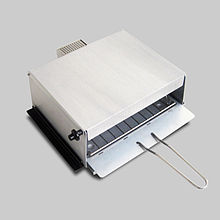Salamander (kitchen utensil)
A salamander (from Greek salambe 'fireplace') is an oven with strong top heat. In professional kitchens - e.g. B. those in gastronomy - it is used for gratinating , gratinating , glazing , caramelizing , but also for keeping food warm for a short time. It has a height-adjustable support grid and infrared or halogen heating elements. The top heat, which is many times stronger than other ovens, can be regulated.
In the salamander, dishes are briefly reheated before serving, which often gives them a nice, appetizing shine. However, if the plates are left under infrared heating for too long , the food will dry out.
Originally, the kitchen salamander was a flat branding iron that was heated in or over the fire to a glowing temperature and then held over the food to be gratinated for a short or long time as required.
The kitchen utensil owes its mythical - zoological name not to a brand name , but to the observation that salamanders are often found on active volcanoes and the ancient belief that they could survive even in conflagrations.
Web links
Individual evidence
- ↑ Eckhard Supp: Dictionary of Cooking Art. From amuse-bouche to decorative snow . Bibliographisches Institut, Mannheim 2010, ISBN 978-3-411-90307-8 , p. 123 ( limited preview in Google Book search).
- ↑ Peter Mayr: FX Mayr - the healthy diet afterwards. Stay slim and vital after the cure . Haug, Stuttgart 2009, ISBN 978-3-8304-2289-1 , pp. 34 ( limited preview in Google Book search).
- ↑ Anne Terglane-Fuhrer: The language of food preparation. Empirical studies on vertical variation . P. Lang, Frankfurt am Main 1996, ISBN 3-631-48074-1 , p. 177 ( limited preview in Google Book search).
- ^ Peter Wagner: Caramel delicacies: Not without my flambé burner! In: Spiegel Online. July 10, 2011, accessed September 30, 2015 .
